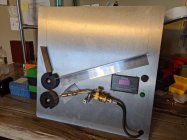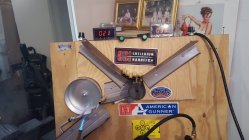Well.... I finally got this thing built. Its been setting here for 2 weeks waiting to be test driven.
This morning, plenty of coffee, no grandpa duty, the war department is sleeping in so here we go.
And as luck would have it, the darn motors don't match each other with their speed. I have them wired to the same controller. Good solid connections. Wheels are same diameter. Everything is humming like an old Model M Farmall.
Except they don't match each other. After running for about ten minutes, the cartridge notches get out of time with each other.
I sure hope one of you fine gentleman with an electrical background can enlighten me on a simple fix. I don't want to run the motors separate with 2 different power supplies if I can keep from it.
I'll also say that at 12 bucks per motor, I probably got what I paid for.
Any help is appreciated.
-

PXL_20210320_162828850.jpg
408.6 KB
· Views: 223
Proud Armenian
Gold $$ Contributor
I must say very clean job!!
I do have electrical background but don't think you can control two motors for two different speeds with one controller unless you have gears involved in the equations.
Curious, why didn't you do two controllers?
Added, I know it did not solve your issue, but that is all my little brain can handle.
I would have tried to keep it a little simpler by using just one motor and a set of gears to drive the wheels at the same speed. In your case, it'd take a little reengineering to do something like that.
What I have are two identical motors wired to the same power source. I am under the impression I want both motors to turn at identical speeds. That's why I didn't incorporate the second controller into the design. I know I can mark the center bolt with a good line and after a few minutes, they no longer coincide with each other.
I must say very clean job!!
I do have electrical background but don't think you can control two motors for two different speeds with one controller unless you have gears involved in the equations.
Curious, why didn't you do two controllers?
Added, I know it did not solve your issue, but that is all my little brain can handle.
Thanks for the compliment.
Proud Armenian
Gold $$ Contributor
Just a thought, what if you change the timing position of one of the motors? For example, if the feeder drum notch is at 12 position, the other drum to be at 3 position.
(These are just random position that I mentioned)
Just a thought, what if you change the timing position of one of the motors? For example, if the feeder drum notch is at 12 position, the other drum to be at 3 position.
(These are just random position that I mentioned)
Your thoughts are absolutely right on. Problem is(I think) that unless the two motors are running at same rpm, the timing position changes. That is what I am experiencing.
Proud Armenian
Gold $$ Contributor
Your thoughts are absolutely right on. Problem is(I think) that unless the two motors are running at same rpm, the timing position changes. That is what I am experiencing.
Ohhhh I see. Now I get it.
In that case gears won't help much.
I would have done one motor and used a belt.
I would have done one motor and used a belt.
Toothed timing belt and sprockets, ideal application IMO.
If the angle timing between the two wheels must be maintained, my guess would have been to use one motor and a timing belt drive to the second wheel.
Getting two independent motors to sync up just based on their own performance usually requires using a tach signal and a servo to be reliable. In other words, there shouldn’t be any assumption that inexpensive gear motors have the features to sync up and stay locked together over long runs.
It may be possible you have more than enough torque margin with one motor and a slave axle by using a timing belt and one of your existing motors, but you will need to gin up that second axle. The drive wheels and drive belt shouldn’t be difficult to find based on shaft size.
ETA: tensioning the belt means one shaft must move a little, or you must use a tension idler. Sometimes your belt selection lets you get away with no adjustment. YMMV
Nice build!
I made one a few years ago, and the plans I got off another forum used a speed control for each motor. I guess the variance of actual RPM is why.
And having a speed controller on each motor is not a set-and-forget either. One always turns a bit different speed. It might be because the cases in the feed tray make enough resistance to slow that motor down just enough for it to become out of sequence after 10-20 turns.
If you can belt/chain/gear drive the second one, they'd have to stay matched up.
All you need is speed controllers on each motor. Thats what all the homemade units that work use. Theres a multitude of reasons why the simplest is your motors and controllers are never matched, not even drives costing thousands are matched, neither are motors that are made back to back. Id put seperate controllers on there with digital readouts so once you get them matched you can note the numbers. Sometimes the cheaper you go the more workarounds you need
This is my favorite place to get project stuff like for this
This is my favorite place to get project stuff like for this
Definitely been interesting to build. Kick myself in the ass for not going ahead and designing in the second controller. I bought it but had a brain fart and decided I didn't need it. And here we are
So here's a thought... Could you not put one of the controllers between your primary controller and the faster of the two motors? The idea being to use that device to tune the faster motor down to the same speed as the slower motor. Theoretically, you would only be using the primary controller to run the speeds up and down on both units. And not necessarily having to tweak both controllers every time you touch it. Maybe?
As might have already been suggested, use one motor and timing gears (really cheep on ebay)
I went even further, and lost the motor controller and went with a synchronous mains powered motor at constant rpm. Adjusted gears to suit, and simply advance the front wheels to adjust annealing time.
Photos from early version testing. Feed ramps modified a bit since then.
Keep it simple.
-

Screenshot_20210321-100823_Gallery.jpg
257.1 KB
· Views: 95
-

Screenshot_20210321-100922_Video Player.jpg
453.1 KB
· Views: 90
All you need is speed controllers on each motor. Thats what all the homemade units that work use. Theres a multitude of reasons why the simplest is your motors and controllers are never matched, not even drives costing thousands are matched, neither are motors that are made back to back. Id put seperate controllers on there with digital readouts so once you get them matched you can note the numbers. Sometimes the cheaper you go the more workarounds you need
Yes.
I built mine with two potentiometers controlling two motors.

Trying to make a modification and electronically synchronize the two motors seems much more difficult that just going with some kind of gear/pully system. Apparently, to do it right, one needs an encoder system to keep the rpm of both motors consistent and adjust for load variances as they are operated. But if one is a handy tinkerer and as a hobbyist, the effort and expense probably wouldn't matter.


Dual-motor systems have been widely used in industrial applications, and speed synchronization of the motors can always be deteriorated by system parameter uncertainties and load torque perturbations. In this paper, a new robust control strategy for the dual-motor systems is developed by...

www.hindawi.com
Learn how to determine the encoder resolution your application requires, calculate the maximum resolution your system can support and how to avoid over-specifying.

www.dynapar.com
Trying to make a modification and electronically synchronize the two motors seems much more difficult that just going with some kind of gear/pully system. Apparently, to do it right, one needs an encoder system to keep the rpm of both motors consistent and adjust for load variances as they are operated. But if one is a handy tinkerer and as a hobbyist, the effort and expense probably wouldn't matter.


Dual-motor systems have been widely used in industrial applications, and speed synchronization of the motors can always be deteriorated by system parameter uncertainties and load torque perturbations. In this paper, a new robust control strategy for the dual-motor systems is developed by...

www.hindawi.com
Learn how to determine the encoder resolution your application requires, calculate the maximum resolution your system can support and how to avoid over-specifying.

www.dynapar.com
Good Lord. That's so far over my head it ain't even funny. I'm going to try my idea mentioned earlier just for grins. It's super easy to wire. So why not. I'll let y'all know if I burn the house down
















